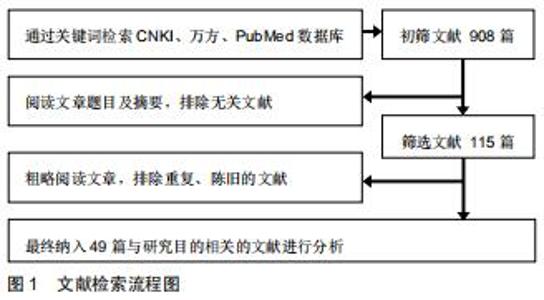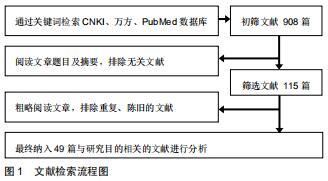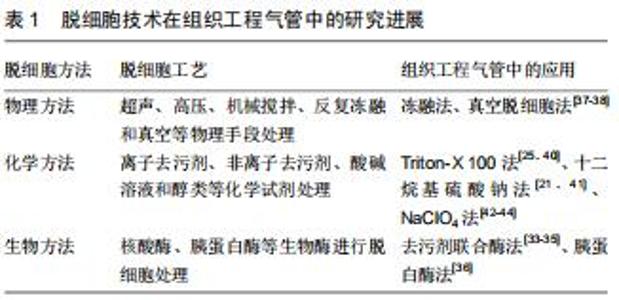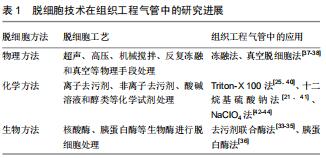Chinese Journal of Tissue Engineering Research ›› 2020, Vol. 24 ›› Issue (35): 5695-5700.doi: 10.3969/j.issn.2095-4344.2773
Previous Articles Next Articles
Application and characteristics of decellularization technology in tissue engineered trachea
Wang Zhihao, Wu Cong, Wu Sihua, Shi Hongcan
Yangzhou University School of Clinical Medicine, Yangzhou University Transformation Medical Center, Jiangsu Provincial Key Laboratory of Geriatric Disease Prevention and Treatment with Integrated Traditional Chinese and Western Medicine, Yangzhou 225001, Jiangsu Province, China
-
Received:2019-12-30Revised:2020-01-07Accepted:2020-02-26Online:2020-12-18Published:2020-10-19 -
Contact:Shi Hongcan, Chief physician, Professor, Doctoral supervisor, Yangzhou University School of Clinical Medicine, Yangzhou University Transformation Medical Center, Jiangsu Provincial Key Laboratory of Geriatric Disease Prevention and Treatment with Integrated Traditional Chinese and Western Medicine, Yangzhou 225001, Jiangsu Province, China -
About author:Wang Zhihao, Master candidate, Yangzhou University School of Clinical Medicine, Yangzhou University Transformation Medical Center, Jiangsu Provincial Key Laboratory of Geriatric Disease Prevention and Treatment with Integrated Traditional Chinese and Western Medicine, Yangzhou 225001, Jiangsu Province, China -
Supported by:the National Natural Science Foundation of China, No. 81770018; the Postgraduate Research Innovation Program of Jiangsu Province, No. XKYCX19_153
CLC Number:
Cite this article
Wang Zhihao, Wu Cong, Wu Sihua, Shi Hongcan. Application and characteristics of decellularization technology in tissue engineered trachea[J]. Chinese Journal of Tissue Engineering Research, 2020, 24(35): 5695-5700.
share this article
|
[1] ETIENNE H, FABRE D, CARO AG, et al. Tracheal replacement. Eur Respir J. 2018;51:17022112.
[2] CROWLEY C, BIRCHALL M, SEIFALIAN AM. Trachea transplantation: from laboratory to patient. Tissue Eng Regen M. 2015;9(4):357-367.
[3] FISHMAN J M, WILES K, LOWDELL MW, et al. Airway tissue engineering: an update. Expert Opin Biol Th. 2014;14(10): 1477-1491.
[4] 杨文龙,张思泉,张国中,等. 京尼平交联脱细胞气管支架种植自体骨髓间充质干细胞的体内原位移植研究[J].国际生物医学工程杂志, 2019,42(5):375-382.
[5] BOGAN SL, TEOH GZ, BIRCHALL MA. Tissue engineered airways: a prospects article. J Cell Biochem. 2016;117(7):1497-1505.
[6] GHORBANI F, MORADI L, SHADMEHR MB, et al. In-vivo characterization of a 3D hybrid scaffold based on PCL/decellularized aorta for tracheal tissue engineering. J Cell Biochem. 2017;81:74-83.
[7] BATIOGLU-KARAALTIN A, OVALI E, KARAALTIN MV, et al. Decellularization of trachea with combined techniques for tissue-engineered trachea transplantation. Clin Exp Otorhinolar. 2019; 12(1):86-94.
[8] ELLIOTT MJ, DE COPPI P, SPEGGIORIN S, et al. Stem-cell-based, tissue engineered tracheal replacement in a child: a 2-year follow-up study. Lancet. 2012;380(9846):994-1000.
[9] 蒋媛,徐艳飞,张思泉,等.两种脱细胞方法制备组织工程气管基质的比较[J].中国组织工程研究,2016,20(51):7642-7647.
[10] GILPIN A, YANG Y. Decellularization strategies for regenerative medicine: from processing techniques to applications. Biomed Res Int. 2017;2017:9831534.
[11] GOKTAS S, MATUSKA AM, PIERRE N, et al. Decellularization method influences early remodeling of an allogenic tissue scaffold. J Biomed Mater Res A. 2014;102(1):8-16.
[12] PETROSYAN A, DA SACCO S, TRIPURANENI N, et al. A step towards clinical application of acellular matrix: A clue from macrophage polarization. Matrix Biol. 2017;57-58(SI):334-346.
[13] FAULK DM, JOHNSON SA, ZHANG L, et al. Role of the extracellular matrix in whole organ engineering. J Cell Physiol. 2014;229(8): 984-989.
[14] CRAPO PM, GILBERT TW, BADYLAK SF. An overview of tissue and whole organ decellularization processes. Biomaterials. 2011; 32(12): 3233-3243.
[15] 范利梅,夏荣,窦晓晨.不同脱细胞方式下所得胞外基质存在的差异[J]. 中国组织工程研究,2014,18(30):4863-4867.
[16] FUNAMOTO S, NAM K, KIMURA T, et al. The use of high-hydrostatic pressure treatment to decellularize blood vessels. Biomaterials. 2010; 31(13):3590-3595.
[17] FLYNN LE. The use of decellularized adipose tissue to provide an inductive microenvironment for the adipogenic differentiation of human adipose-derived stem cells. Biomaterials. 2010;31(17): 4715-4724.
[18] XING Q, YATES K, TAHTINEN M, et al. Decellularization of fibroblast cell sheets for natural extracellular matrix scaffold preparation. Tissue Eng Part C Methods. 2015;21(1):77-87.
[19] Den HONDT M, VANAUDENAERDE BM, MAUGHAN EF, et al. An optimized non-destructive protocol for testing mechanical properties in decellularized rabbit trachea. Acta Biomater. 2017; 60:291-301.
[20] LANGE P, SHAH H, BIRCHALL M, et al. Characterization of a biologically derived rabbit tracheal scaffold. J Biomed Mater Res B. 2017;105(7):2126-2135.
[21] HUNG S, SU C, LIN S, et al. Preliminary experiences in trachea scaffold tissue engineering with segmental organ decellularization. Laryngoscope. 2016;126(11):2520-2527.
[22] SYED O, WALTERS N J, DAY RM, et al. Evaluation of decellularization protocols for production of tubular small intestine submucosa scaffolds for use in oesophageal tissue engineering. Acta Biomaterialia. 2014; 10(12):5043-5054.
[23] SUN F, PAN S, SHI H, et al. Structural integrity, immunogenicity and biomechanical evaluation of rabbit decelluarized tracheal matrix. J Biomed Mater Res A. 2015;103(4):1509-1519.
[24] CHEN L, HE S, ZHUANG J, et al. A novel method to acquire decellularized tracheal matrix from neonatal rabbit. J Biomater Tiss Eng. 2016;6(5):400-407.
[25] ZHANG F, WANG Z, ZHENG C, et al. Biocompatibility and cellular compatibility of decellularized tracheal matrix derived from rabbits. Int J Artif Organs. 2019;42(9):500-507.
[26] PARTINGTON L, MORDAN N J, MASON C, et al. Biochemical changes caused by decellularization may compromise mechanical integrity of tracheal scaffolds. Acta Biomater. 2013; 9(2):5251-5261.
[27] ZANG M, ZHANG Q, CHANG EI, et al. Decellularized tracheal matrix scaffold for tissue engineering. Plast Reconstr Surg. 2012; 130(3): 532-540.
[28] CEBOTARI S, TUDORACHE I, JAEKEL T, et al. Detergent decellularization of heart valves for tissue engineering: toxicological effects of residual detergents on human endothelial cells. Artif Organs. 2010;34(3):206-209.
[29] XU Y, LI D, YIN Z, et al. Tissue-engineered trachea regeneration using decellularized trachea matrix treated with laser micropore technique. Acta Biomater. 2017;2017,58:113-121. [30] OHNO M, FUCHIMOTO Y, HSU H, et al. Airway reconstruction using decellularized tracheal allografts in a porcine model. Pediatr Surg Int. 2017;33(10):1065-1071.
[31] Den HONDT M, VANAUDENAERDE BM, VERBEKEN EK, et al. Epithelial grafting of a decellularized whole-tracheal segment: an in vivo experimental model. Interact Cardiov Th. 2018;26(5):753-760.
[32] ZANG M, ZHANG Q, CHANG E I, et al. Decellularized tracheal matrix scaffold for tracheal tissue engineering: in vivo host response. Plast Reconstr Surg. 2013;132(4):549E-559E.
[33] BAIGUERA S, DEL GAUDIO C, KUEVDA E, et al. Dynamic decellularization and cross-linking of rat tracheal matrix. Biomaterials. 2014;35(24):6344-6350.
[34] MACCHIARINI P, JUNGEBLUTH P, GO T, et al. Clinical transplantation of a tissue-engineered airway. Lancet. 2008; 372(9655): 2023-2030.
[35] GONFIOTTI A, JAUS MO, BARALE D, et al. The first tissue-engineered airway transplantation: 5-year follow-up results. Lancet. 2014;383(9913):238-244.
[36] GIRALDO-GOMEZ DM, LEON-MANCILLA B, DEL PRADO-AUDELO ML, et al. Trypsin as enhancement in cyclical tracheal decellularization: morphological and biophysical characterization. Mat Sci Eng C Mater. 2016;59:930-937.
[37] BUTLER CR, HYNDS RE, CROWLEY C, et al. Vacuum-assisted decellularization: an accelerated protocol to generate tissue-engineered human tracheal scaffolds. Biomaterials. 2017; 124:95-105.
[38] LANGE P, GRECO K, PARTINGTON L, et al. Pilot study of a novel vacuum-assisted method for decellularization of tracheae for clinical tissue engineering applications. J Tissue Eng Regen M. 2017;11(3): 800-811.
[39] KITAHARA H, YAGI H, TAJIMA K, et al. Heterotopic transplantation of a decellularized and recellularized whole porcine heart. Interact Cardiovasc Thorac Surg. 2016;22(5):571-579.
[40] REMLINGER NT, CZAJKA CA, JUHAS ME, et al. Hydrated xenogeneic decellularized tracheal matrix as a scaffold for tracheal reconstruction. Biomaterials. 2010;31(13):3520-3526.
[41] DIMOU Z, MICHALOPOULOS E, KATSIMPOULAS M, et al. Evaluation of a decellularization protocol for the development of a decellularized tracheal scaffold. Anticancer Res. 2019;39(1): 145-150.
[42] PAN S, SUN F, SHI H, et al. Evaluation of an immune-privileged scaffold for in vivo implantation of tissue-engineered trachea. Biotechnol Bioproc E. 2014;19(5):925-934.
[43] KISELEVSKY MV, ANISIMOVA NY, LEBEDINSKAYA OV, et al. Optimization of a method for preparation and repopulation of the tracheal matrix for allogenic transplantation. Bull Exp Biol Med. 2011;151(1):107-113.
[44] KISILEVSKII MV, ANISIMOVA N, LEBEDINSKAIA OV, et al. Heterotopic transplantation of non-immunogenic trachea populated with recipient bone marrow stromal cells. Morfologiia. 2012; 141(1): 66-70.
[45] BAIGUERA S, JUNGEBLUTH P, BURNS A, et al. Tissue engineered human tracheas for in vivo implantation. Biomaterials. 2010;31(34): 8931-8938.
[46] SUN F, JIANG Y, XU Y, et al. Genipin cross-linked decellularized tracheal tubular matrix for tracheal tissue engineering applications. Sci Rep Uk. 2016;6:24429.
[47] CHEN Y, CHEN J, ZHANG Z, et al. Current advances in the development of natural meniscus scaffolds: innovative approaches to decellularization and recellularization. Cell Tissue Res. 2017;370(1): 41-52.
[48] HAMILTON NJ, KANANI M, ROEBUCK DJ, et al. Tissue-engineered tracheal replacement in a child: a 4-year follow-up study. Am J Transplant. 2015;15(10):2750-2757. [49] TAN Q, LIU R, CHEN X, et al. Clinic application of tissue engineered bronchus for lung cancer treatment. J Thorac Dis. 2017;9(1):22-29. |
| [1] | Wang Hao, Chen Mingxue, Li Junkang, Luo Xujiang, Peng Liqing, Li Huo, Huang Bo, Tian Guangzhao, Liu Shuyun, Sui Xiang, Huang Jingxiang, Guo Quanyi, Lu Xiaobo. Decellularized porcine skin matrix for tissue-engineered meniscus scaffold [J]. Chinese Journal of Tissue Engineering Research, 2021, 25(22): 3473-3478. |
| [2] | Liu Zhigang, Guo Qinggong, Chen Jingtao. Effect of Capparis spinosa total alkaloid on proliferation and apoptosis of nucleus pulposus cells in an intervertebral disc degeneration rat model [J]. Chinese Journal of Tissue Engineering Research, 2021, 25(11): 1699-1704. |
| [3] | Luo Yaxin, Bi Haoran, Chen Xiaoxu, Yang Kun. Extracellular matrix and tissue engineering regeneration and repair [J]. Chinese Journal of Tissue Engineering Research, 2021, 25(11): 1785-1790. |
| [4] | Li Junqi, Tian Guangzhao, Chen Mingxue, Wang Hao, Liu Shuyun, Sui Xiang, Huang Jingxiang, Li Ming, Guo Quanyi. Regulatory effect of acellular cartilage extracellular matrix on phenotype of mouse macrophage line [J]. Chinese Journal of Tissue Engineering Research, 2021, 25(10): 1512-1516. |
| [5] | Guo Haoyu, Li Weiquan, Liu Kaiyuan, Xiao Ruifen, Sun Denglong, Xi Jiaoya. Recent research progress in construction of biomimetic engineered cardiac tissue based on extracellular matrix [J]. Chinese Journal of Tissue Engineering Research, 2021, 25(10): 1577-1584. |
| [6] | Wu Ming, Zhang Yan. Related factors regulating osteogenic differentiation of bone marrow mesenchymal stem cells through Wnt/β-catenin signaling pathway [J]. Chinese Journal of Tissue Engineering Research, 2021, 25(1): 116-122. |
| [7] | Liu Chunyu, Han Xiaoyan, Wang Lin. Basic science related to tendinopathy: microbiomechanics and stress shielding [J]. Chinese Journal of Tissue Engineering Research, 2020, 24(5): 766-772. |
| [8] | Yang Wenxiao, Yang Ning, Liu Yao. Immunomodulation of extracellular matrix and its role in tissue regeneration [J]. Chinese Journal of Tissue Engineering Research, 2020, 24(35): 5701-5707. |
| [9] | He Jing, Ao Qiang. Research hotspots in tissue decellularization method for manufacturing extracellular matrices [J]. Chinese Journal of Tissue Engineering Research, 2020, 24(34): 5413-5420. |
| [10] | Cheng Xue, Fang Hong, Zhang Yunke, Wu Yingen. Interventional mechanism of Feibi prescription on extracellular matrix transformation in a mouse model of pulmonary fibrosis [J]. Chinese Journal of Tissue Engineering Research, 2020, 24(31): 5038-5043. |
| [11] | Liu Guoming, Wang Qinfen, Lin Kefeng, Zhou Shiguo, Chen Zuxing, Lin Shishui. Whole body application of nerve growth factor promotes early healing of tibial shaft fracture and improves expression of bone morphogenetic protein-2 and vascular endothelial growth factor in rats [J]. Chinese Journal of Tissue Engineering Research, 2020, 24(29): 4680-4685. |
| [12] | Zhang Weizhong, Li Lei, He He, He Xin. Application and significance of nanofibrous macroporous scaffold preparation technology for bone tissue engineering [J]. Chinese Journal of Tissue Engineering Research, 2020, 24(28): 4437-4444. |
| [13] | Shi Jun, Yang Lin, Guo Zhibin, Cui Yutao, Liu He. How does extracellular matrix-based growth factor delivery system promote osteogenesis? [J]. Chinese Journal of Tissue Engineering Research, 2020, 24(28): 4445-4451. |
| [14] | Chen Leyi, Lü Xiaolin, Xu Wenan. Scaffolds for dental pulp regeneration and revascularization [J]. Chinese Journal of Tissue Engineering Research, 2020, 24(28): 4452-4458. |
| [15] | Xin Pengfei, Sun Youqiang, Li Jie, Chen Jianfa, Deng Baogui, Xiang Xiaobing . Research progress of biomaterials for repair of rotator cuff tear [J]. Chinese Journal of Tissue Engineering Research, 2020, 24(28): 4459-4464. |
| Viewed | ||||||
|
Full text |
|
|||||
|
Abstract |
|
|||||



